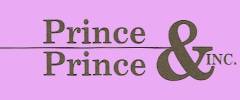 A
Prince & Prince Market Report
A
Prince & Prince Market Report
Insight
from the Prince & Prince U.S. Consumer Floral Tracking Survey
Dr. Thomas L. Prince
Dr. Timothy A. Prince
Prince & Prince, Inc.
Columbus, OH USA
FloralMarketResearch.com
Release
Date: January, 2012

Special
Note: This feature article is
based on new research findings excerpted from the updated Prince & Prince
(P&P) Seminar, “The US Consumer Floral Tracking Survey”.
The Valentine’s Day purchasing metric is one of over 100 floral
metrics highlighted in the P&P seminar.
This P&P consumer research was sponsored by Smithers-Oasis, N.A. P&P sincerely thank Smithers-Oasis for their
support in making this 2010 research update possible, providing benefit for
the entire US floral industry.

Valentine’s Day is one of several key floral
occasions in the US where consumers collectively express their emotions of love
and affection for others, largely thru the purchase of fresh cut flowers and
potted plants. While this
“floral holiday” has traditionally been one of the strongest floral sales
occasions for retail florists and floral mass marketers, the deep 2008 recession
and resulting sluggish economic climate in the US now poses new challenges for
retailers and companies throughout the floral-supply chain for holiday sales, as
well as for floral sales throughout the year.
In this reporting, Prince & Prince (P&P)
shows an historical profile of consumer household floral purchasing for
Valentine’s Day, findings excerpted from the updated P&P seminar, “The
US Consumer Floral Tracking Survey” (see About the P&P Survey in
Appendix). The Valentine’s
Day purchasing metric is just one of over 100 consumer floral-purchasing metrics
collected in the consumer tracking research, and detailed with analysis in the
P&P seminar (see Table 1 for seminar topics). The consumer floral-purchasing data, collected at three
time-intervals over the past decade (before the recent US recession, year 2000
and 2007, and after, 2010) reveals how the 2008 recession has impacted floral
purchasing for various holidays, occasions, and events, including Valentine’s Day.
In addition, demographic data from the P&P survey identifies key and
emerging trends that drive floral purchasing for Valentine’s Day in spite of
the recession. A fuller understanding of these consumer demographic
trends will likely assist the floral industry in making this upcoming
Valentine’s Day the best ever.
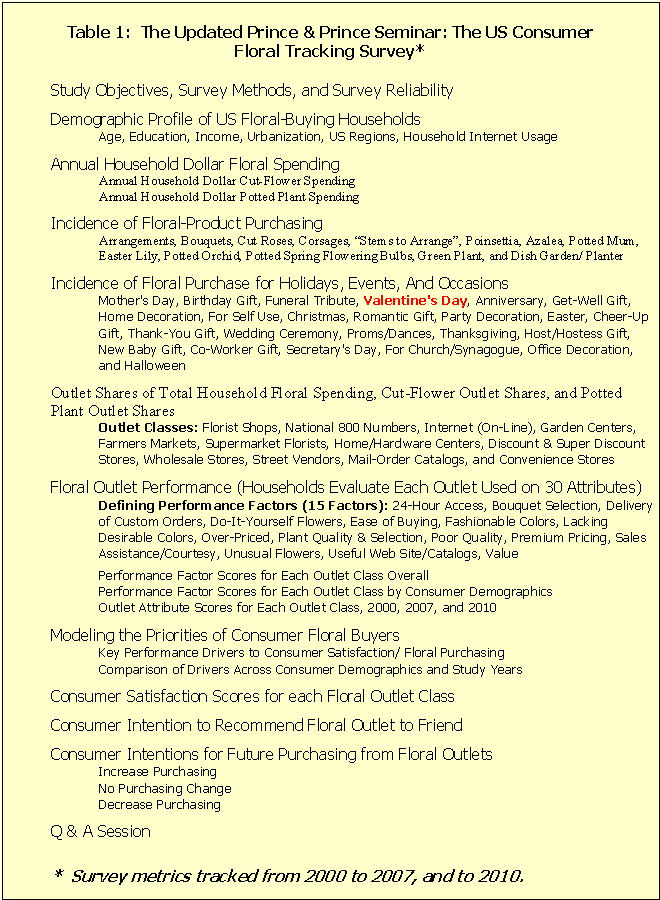
Floral
Purchasing for Valentine’s Day is Largely Resilient to US Economic Woes
Figure 1 reveals that across 1,280
randomly-selected floral-buying households nationwide in 2010, 52% had purchased
one or more floral products for Valentine’s Day (incidence of purchasing
floral, cut flowers and/or indoor potted plants, see definition in Appendix).
This compares to a similar household purchase incidence of 51% and 52% in
year 2007 and 2000, respectively. As
in the 2007 study, Valentine’s Day was ranked the third highest incidence of
floral purchase among 24 holidays, events and occasions measured in the P&P
consumer research (trailing Mother’s Day, and Birthday events).
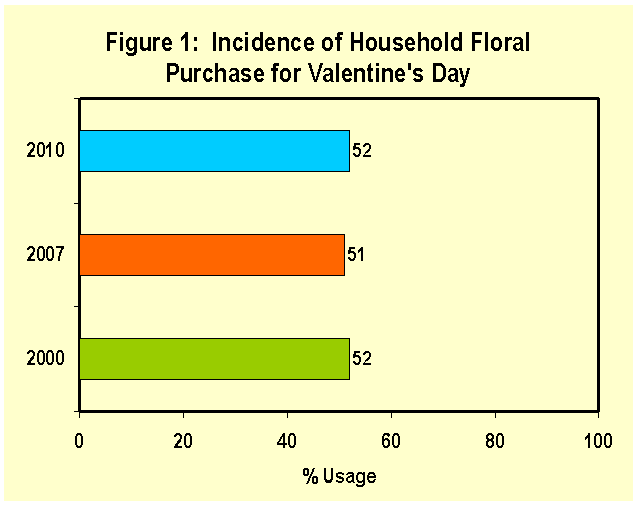
The relatively high percentages of household floral purchasing across the three
study periods indicates that Valentine’s Day is a very important holiday for
the floral industry, as over half of all floral-buying households in the US make
at least one floral purchase for this holiday.
From P&P market research, P&P estimates that in 2010, about 75
million households in the US were floral-buying households, making one or more
floral purchases throughout the year (contact P&P for details on this
estimate). Thus, P&P projects that nearly 39 million
households bought for Valentine’s Day in 2010.
And this relatively-high incidence of consumer floral purchasing for
Valentine’s Day has not waned since the recession of 2008.
Notwithstanding, these purchasing estimates also suggest that the
industry still has a way to go in fully penetrating the US market for
Valentine’s Day before considering this holiday “topped out” from the
demand side.
While
Purchasing Incidence Remains Robust, Dollar
Spending per Household Likely Slipped in 2010
The
P&P Consumer Floral Tracking Survey does not collect individual floral
transaction data, thus P&P cannot make precise estimates of household floral
spending (US dollars) attributable to specific holidays, events, and occasions.
However, the P&P survey does capture annual household floral spending
for households that have purchased floral for Valentine’ Day, and for those
households that have not. Thus,
P&P is able to compute an estimate of “spending attributable to
Valentine’s Day” for both 2007 and 2010, and calculate the percentage change
from 2007 to 2010. While
there is likely some upward bias in calculating “attributable spending”
estimates in this manner (contact P&P for details about this bias), the
upward bias would likely be similar across both studies.
P&P’s key interest is in determining the percentage change in these
estimates between 2007 and 2010, not the actual size of the estimates.
For
2007, the P&P estimate of average household floral spending “attributable
to Valentine’s Day” was $84, including all household members making a floral
purchase, and with associated delivery/ service fees included.
For 2010, the average estimate was $67, a 20% slide from the 2007
estimate. While the household
spending estimates, on average, may appear somewhat “puffy” (likely due to
the upward bias), the estimated 20% decline in household Valentine’s Day
spending from 2007 to 2010 appears plausible.
Thus, while over one-half of US floral-buying households remained
committed to making a floral purchase for Valentine’s Day in 2010, they likely
did so with less dollars than in 2007.
However, the 2010 slippage in floral spending cannot be fully
attributable to the 2008 recession, as the 2010 Valentine’s Day week-end date
(Sunday) likely induced last-minute consumer purchasing, shifting some household
floral buying to supermarkets and other floral mass-marketers for the week-end
occasion, with availability of generally lower-priced floral products compared
to more traditional florist outlets.
With the upcoming Valentine’s Day falling on a Tuesday, traditional
florist outlets may fare much better in 2012.
Specific Consumer
Groups Drive Floral Purchasing Dynamics
To identify specific consumer groups that drive
floral purchasing for Valentine’s Day in spite of the recession, P&P
segmented the overall survey findings by ten household demographic
characteristics (demographics shown in Appendix, Table 2).
In this reporting, P&P highlights two key demographic characteristics
that largely increase household floral purchasing for Valentine’s Day: age of
householder, and presence of teenagers in the household.
P&P also discusses analytics revealed in the P&P seminar related
to annual household income and annual household floral spending, and their
impact on consumer purchasing for Valentine’s Day.
Younger
Consumers and “Mature Romantics” Lead Purchasing Trends
Valentine’s Day floral purchasing varies significantly by age of
householder, and younger-aged consumers show a much higher incidence of
floral purchase (Figure 2). As
was shown in the P&P 2000 and 2007 studies, consumer households under the
age of 35 again show the highest relative incidence of floral purchase for
Valentine’s Day in 2010 (59%), compared to the other age groups.
These findings brings into bold relief the fact that Valentine’s Day is
one of the key occasions to involve young consumers, and likely new floral
buyers, with fresh floral products.
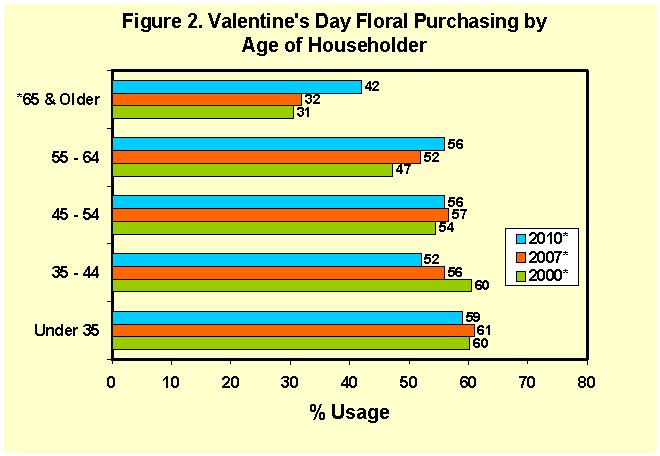
The 2010 P&P research also reveals a new
purchasing trend emerging for consumers aged 55 and older, a relatively large
group which includes part of the US “baby boomer” generation.
For these more mature consumers, floral-purchasing incidence is now
increasing for Valentine’s Day. In
fact, the “65 & Older” age group showed a strong, statistically
significant ten percentage-point gain in purchasing incidence for 2010 compared
to the 2007 data (a 30% increase). And
the slightly younger “55 to 64” age group is also now trending in the same
upward direction. P&P
terms this emerging Valentine’s Day demographic trend, “Mature Romantics”
(the P&P seminar offers numerous data-grounded explanations for these
consumer floral purchasing trends). Overall,
the P&P consumer research identifies “recession-buster” opportunities
for Valentine’s Day at both ends of the consumer age spectrum, with
opportunities for distinct floral products targeted at younger and older (age 55
& up) segments, thus broadening the Valentine’s Day floral offering.
Teenagers
within the Household Compound Floral Purchasing
As was shown in the 2007 P&P study, the presence of teenagers
within the household again had a dramatic impact on increasing household floral
purchasing for Valentine’s Day 2010 (Figure 3).
For 2010, almost 20% of all floral-buying households in the P&P
survey reported teenagers within the household.
For floral-buying households without teenagers, Valentine’s Day
purchase likelihood was 50% in 2010.
However, with teenagers present within the household, the floral purchase
likelihood jumps thirteen percentage points to 63%.
This represents a greater than 25% gain in floral purchase likelihood for
Valentine’s Day due to teenagers within the household.
This strong increase in Valentine’s Day floral purchasing attributable
to teenagers has been maintained since 2000, when the P&P survey first
initiated measurement of teenager membership within the household, and the
increase in purchasing has been largely maintained through the 2008 recession.
This durable purchasing trend again exemplifies the importance of
broadening the Valentine’s Day floral offering with age-appropriate floral
products, expanding upon the floral demand trends revealed with the householder
age findings.
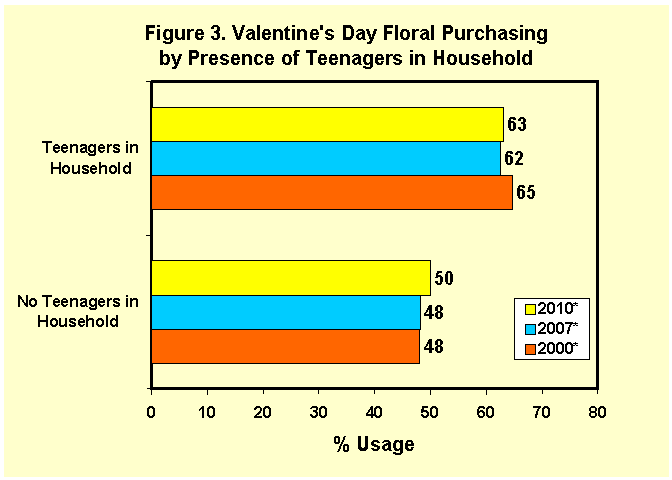
Lower
Incomes Generally Expand Purchasing, But Higher Incomes Contract
The
P&P seminar findings detail the effects that specific household income and
floral spending levels have on the likelihood of consumer purchasing for
Valentine’s Day (as well as for the 20+ other holidays, events, and occasions,
and for over a dozen cut-flower & potted plant categories measured in the
P&P consumer research). With
this consumer purchase-trend information, the floral opportunities for
Valentine’s Day up and down the income and floral-spending “ladders” are
clearly identified. These
demand trends have implications for the development of new product strategies,
and possibly new channel strategies, for capturing “Valentine’s Day
Cupids” in specific income and floral-spending groups.
As an indicator
of the consumer demand dynamics for Valentine’s Day, the seminar findings
revealed a significant increase in household floral purchasing for Valentine’s
Day in 2010 among the lowest income earners (household incomes under $25,000).
In addition, Valentine’s Day floral purchasing trended upward for the
next highest income group, those earning between $25,000 to $50,000 annually.
However, for the top three household income groups, collectively those
with household incomes over $50,000 (and with higher purchasing levels), the
incidence of purchasing for Valentine’s Day 2010 showed mixed or declining
trends. One higher income group
re-bounded in 2010, while the other two declined.
The P&P seminar findings reveal the swings in Valentine’s Day
floral purchasing attributable to the recession for each income and
floral-spending group, and those swings were somewhat more volatile for the
higher income and higher floral-spending groups.
Summary
The newly updated P&P Seminar, “The US Consumer
Floral Tracking Survey,” presents the US floral industry with an historical
profile of consumer floral purchasing trends for numerous holidays, events, and
occasions, and for more than a dozen floral-product categories.
This reporting highlighted consumer floral purchasing for Valentine’s
Day, with metrics captured before and after the 2008 recession. For 2010, the incidence of floral purchasing for
Valentine’s Day remained relatively strong and was largely resilient to the
2008 economic recession, although consumers likely traded down to lower-priced
floral offerings, yet still made a purchase.
Now, in this post-recession era, the key “market story” for the
floral industry is that younger-aged householders (under age 35), households
with teenagers, the mature segment over the age of 55, and lower-income
households collectively drive the floral-purchasing dynamics for Valentine’s
Day. How the floral
industry adapts to and exploits these demographic purchasing opportunities, and
meets the challenges inherent in serving these more unique market segments will
largely determine whether Valentine’s Day continues to remain a key purchasing
holiday for the industry.
Afterword.
The information in this article was obtained from the updated P&P
Consumer Seminar, “The US Consumer Floral Tracking Survey”, which P&P
now offers to members of the floral industry.
The on-site seminar covers the complete consumer floral tracking
research, revealing numerous “stories” about emerging US floral-market
trends, the changing floral channels, and the opportunities that are currently
unfolding for the industry. Contact
P&P for seminar fees and scheduling.
Related Links: The
P&P Consumer Seminar: http://www.floralmarketresearch.com/details.htm
P&P Seminar Offerings: http://www.floralmarketresearch.com/seminars1.htm
Appendix
About
the P&P Survey.
The Prince & Prince (P&P) US
Consumer Floral Tracking Survey has been conducted periodically since 1996, and
tracks consumer floral purchasing at various floral outlets in the United
States. The survey is
administered by first-class mail with a monetary incentive, and is completed by
over 1,000 randomly-selected floral-buying households throughout the US
(P&P does NOT use agency panels or on-line polls), thus the survey
provides a highly reliable and valid probability sample of US floral-buying
households for identifying and projecting floral-market trends.
In the survey, consumers identify the types of floral products that they
purchases (over a dozen cut flower and potted plant products surveyed) and
reveal the holidays, events, and occasions of floral purchasing. Consumers then evaluate the floral offerings,
services, outlet perceptions and image of up to three floral outlets where they
make their floral purchases (over 30 attribute measures for each outlet used).
Collectively, the P&P consumer research answers the following: Who
are the floral consumers of today? What
are they buying? How much are they
spending? Where are they buying?
Why are they buying? How are
the specific floral outlets performing? - - their strengths & weaknesses? In what areas should florists, supermarkets, and other floral
mass-market outlets focus to gain more floral sales? And how has all of this changed since the 2008
recession?
The P&P consumer surveys obtain a
random selection of over 1,000 floral-buying households throughout the US, with
1310, 1065, 1,208, and 1,280 households responding to the survey in 1996, 2000,
2007, and 2010. For ease of
reporting, P&P has restricted the data exposition in this Valentine’s Day
report to consumer surveys conducted over the past decade only (year 2000, 2007,
and 2010 surveys), dropping the more dated 1996 data from the reporting.
Smithers-Oasis, N.A., was the key sponsor for the P&P consumer survey
conducted in the late Summer/ Fall of 2010.
Research
Methods Used by Prince & Prince.
In the P&P consumer surveys, P&P measures the household incidence
of floral purchasing for 24 holidays, occasions, and events, including those
floral purchases made specifically for Valentine’s Day.
P&P defines floral purchasing as the purchasing of fresh cut
flowers (arrangements, bouquets, roses, bunches, “stems-to-arrange”
(do-it-yourself), and corsages) and/or indoor fresh potted plants (flowering
plants, foliage plants, and dish gardens/planters), not outdoor bedding/garden plants. By household purchasing
incidence, P&P means the purchase of one or more floral products by the
household for Valentine Day during the study year. P&P shows the purchasing incidence as the percentage of floral-buying
households that made a floral purchase for Valentine’s Day for the specific survey
years.
In
the presentation of survey findings, P&P shows consumer purchasing data from
the most recent 2010 P&P national consumer survey, and also makes
comparisons with prior P&P consumer surveys conducted in 2007 and in 2000.
This allows P&P to identify trends in consumer floral purchasing
across the past decade for Valentine’s Day.
The P&P survey also collects ten consumer demographic measures that
are used in segmentation analyses, including consumer age, income, education,
urbanization, US region, household composition, and annual level of floral
spending (Table 2).
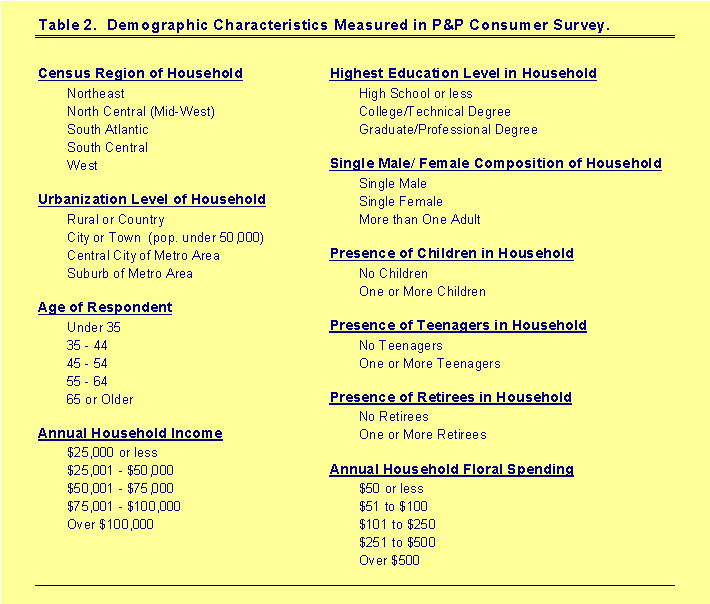
In
this article, P&P highlights historical household floral purchasing trends
for Valentine’s Day, and shows these purchasing trends across several
demographic segments. In the
data charts, an asterisk ( * ) next to a study year denotes a statistically
significant trend across the particular demographic characteristic for that
year. An asterisk next to a
particular demographic category (e.g. income of $25,000 or less) denotes a
significant trend between 2007 and 2010 for that demographic category.
About the Authors. Drs. Tom and Tim Prince, formerly of The Ohio
State University, are brothers and co-founders of Prince & Prince, Inc.
(P&P), a leading marketing research specialist in the floral and green plant
industries. P&P has
completed more than 50 major marketing research projects and reports for the
floral and floral-related industries in the US, and has also conducted floral
marketing research in Canada, the United Kingdom,
Holland, Germany, and Spain. P&P
conceptualize, design, and implement market research projects and product tests
for floral and green-plant suppliers, hardgood suppliers, floral importers,
wholesale florists, retail florists, floral-industry associations, and companies
serving the allied floral trade.
For more information about P&P marketing research & services, and
their informative on-site seminars, visit their web site at FloralMarketResearch.com.
|

